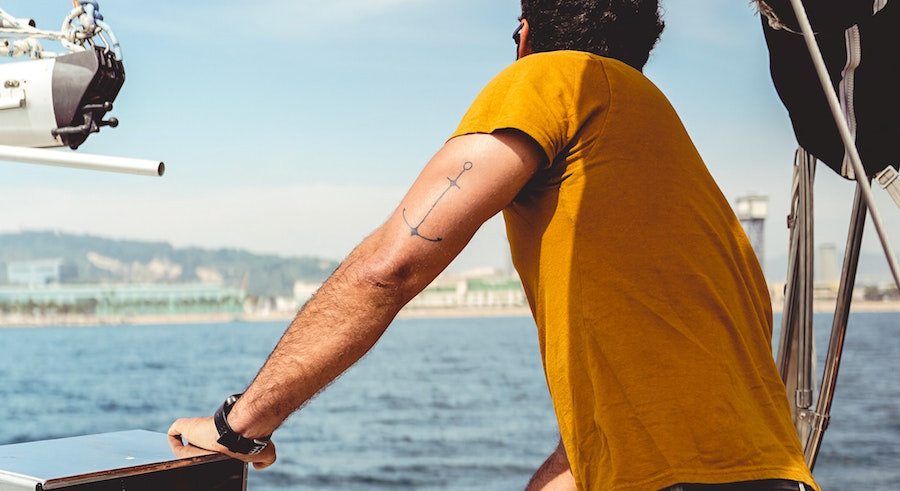Can You Go In Saltwater After Getting A Tattoo? Absolutely, but understanding the healing process and taking necessary precautions are paramount for preserving your tattoo’s integrity and preventing infections. At tattooat.com, we’re dedicated to providing you with expert advice and top-tier insights into the world of tattoos and tattoo artistry, ensuring your body art remains a vibrant expression of your individuality. From understanding the aftercare essentials to exploring the nuances of tattoo healing and avoiding potential health hazards, tattooat.com is your ultimate guide.
1. How Long Should I Wait to Go in Saltwater After a New Tattoo?
It is generally recommended to wait at least 2 to 4 weeks before submerging a new tattoo in saltwater. This waiting period is crucial because a new tattoo is essentially an open wound, and saltwater contains microorganisms that can lead to infection or interfere with the healing process. According to dermatologists at the American Academy of Dermatology, tattoos typically take about 2 to 4 weeks to heal, but this timeframe can vary depending on the individual’s immune system, the size and location of the tattoo, and adherence to aftercare instructions.
 Fresh tattoo on arm healing, depicting the importance of waiting before saltwater exposure
Fresh tattoo on arm healing, depicting the importance of waiting before saltwater exposure
1.1. Why Is It Important to Wait?
Waiting is essential to reduce the risk of infection. Saltwater is home to a myriad of bacteria and other microorganisms. These can infiltrate the broken skin of a fresh tattoo, leading to infections that not only compromise the tattoo’s appearance but also pose potential health risks.
1.2. The Healing Process: What to Expect
The initial stages of tattoo healing involve redness, swelling, and oozing. Over the next few days, a scab will form over the tattooed area. It is vital to allow this scab to heal naturally and avoid picking or scratching it, as this can lead to scarring and uneven ink distribution. During this period, the skin is highly vulnerable, and exposure to saltwater can disrupt the healing process.
1.3. What Factors Affect Healing Time?
Several factors can influence how quickly a tattoo heals, including:
- Individual Health: A robust immune system can expedite healing.
- Tattoo Size and Location: Larger tattoos and those in areas with more friction may take longer to heal.
- Aftercare Practices: Diligent cleaning and moisturizing can promote faster healing.
- Environmental Conditions: Exposure to pollutants or unsanitary conditions can hinder healing.
2. What Are the Risks of Exposing a New Tattoo to Saltwater?
Exposing a new tattoo to saltwater poses several risks, primarily due to the presence of bacteria and other contaminants. Understanding these risks can help you make informed decisions about protecting your new ink.
2.1. Infection
Infection is the most significant risk. Saltwater contains various microorganisms that can enter the broken skin, causing bacterial infections. These infections can manifest as redness, swelling, pain, and pus.
2.2. Delayed Healing
Saltwater can interfere with the natural healing process. The high salt content can dehydrate the skin, leading to cracking and peeling, which can delay healing and increase the risk of scarring.
2.3. Ink Fading
Premature exposure to saltwater can cause the ink to fade or become unevenly distributed. The abrasive nature of salt crystals can damage the outer layers of the skin, affecting the tattoo’s vibrancy.
2.4. Scarring
Infections and improper healing can lead to scarring, which can distort the tattoo’s design and texture. Scar tissue can also affect the skin’s ability to hold ink in the future.
3. How Can I Protect My New Tattoo If I Can’t Avoid Saltwater?
If you find yourself in a situation where you can’t avoid saltwater exposure, taking certain precautions can help minimize the risks to your new tattoo.
3.1. Use Waterproof Bandages
Applying a waterproof bandage over the tattoo can create a protective barrier against saltwater. Ensure the bandage is breathable to prevent moisture buildup, which can also lead to infection.
3.2. Apply a Thick Layer of Tattoo Balm
Before applying the bandage, use a thick layer of tattoo balm to provide an additional layer of protection. Choose a balm that is specifically designed for tattoo aftercare and is free of harsh chemicals.
3.3. Limit Exposure Time
Minimize the amount of time your tattoo is exposed to saltwater. The longer the exposure, the greater the risk of complications.
3.4. Rinse Immediately After Exposure
After exposure to saltwater, rinse the tattooed area thoroughly with clean, fresh water. This helps to remove any salt and contaminants that may have come into contact with the skin.
3.5. Gently Pat Dry and Reapply Balm
After rinsing, gently pat the area dry with a clean towel and reapply a thin layer of tattoo balm. This helps to keep the skin moisturized and supports the healing process.
4. What Are the Best Aftercare Practices for a New Tattoo?
Proper aftercare is crucial for ensuring your tattoo heals correctly and remains vibrant. Following these best practices can significantly reduce the risk of complications.
4.1. Keep the Tattoo Clean
Gently wash the tattoo with mild, fragrance-free soap and warm water 2-3 times a day. Avoid using harsh chemicals or abrasive scrubs.
4.2. Moisturize Regularly
Apply a thin layer of tattoo balm or lotion several times a day to keep the skin moisturized. Choose a product that is specifically designed for tattoo aftercare and is free of alcohol, fragrances, and dyes.
4.3. Avoid Sun Exposure
Protect the tattoo from direct sunlight by wearing loose-fitting clothing or applying a broad-spectrum sunscreen with an SPF of 30 or higher. Sun exposure can cause the ink to fade and damage the skin.
4.4. Wear Loose Clothing
Wear loose-fitting clothing over the tattoo to avoid friction and irritation. Tight clothing can rub against the skin, causing discomfort and potentially disrupting the healing process.
4.5. Stay Hydrated
Drinking plenty of water helps to keep the skin hydrated from the inside out, which can promote faster healing.
5. What Are Signs of a Tattoo Infection and What Should I Do?
Recognizing the signs of a tattoo infection is crucial for seeking prompt medical attention and preventing further complications.
5.1. Redness and Swelling
Increased redness and swelling around the tattoo site can be signs of an infection. While some redness and swelling are normal during the initial stages of healing, persistent or worsening symptoms should be evaluated by a healthcare professional.
5.2. Pain and Tenderness
Excessive pain and tenderness, especially if accompanied by throbbing sensations, can indicate an infection.
5.3. Pus or Drainage
The presence of pus or drainage from the tattoo site is a clear sign of infection. The discharge may be yellow, green, or cloudy.
5.4. Fever and Chills
Systemic symptoms such as fever and chills can indicate that the infection has spread beyond the tattoo site and requires immediate medical attention.
5.5. What to Do If You Suspect an Infection
If you suspect your tattoo is infected, seek medical attention immediately. A healthcare professional can assess the situation and prescribe appropriate treatment, such as antibiotics or topical creams. Avoid self-treating the infection, as this can lead to complications and delay proper healing.
6. Can I Go in a Swimming Pool After Getting a Tattoo?
Similar to saltwater, it’s generally advised to avoid swimming pools for the first 2 to 4 weeks after getting a tattoo. The chlorine and other chemicals in pool water can irritate the skin and increase the risk of infection.
6.1. Risks of Pool Water
Chlorine can dry out the skin, leading to cracking and peeling, which can delay healing and increase the risk of scarring. Additionally, public swimming pools can harbor bacteria and other contaminants that can cause infections.
6.2. Precautions for Swimming Pools
If you must swim in a pool, take the same precautions as with saltwater: use a waterproof bandage, apply a thick layer of tattoo balm, limit exposure time, and rinse thoroughly after swimming.
7. What Are Some Alternatives to Swimming During the Healing Process?
If you’re an avid swimmer, waiting 2 to 4 weeks can feel like a long time. Here are some alternatives to consider during the healing process.
7.1. Dry Land Activities
Engage in dry land activities such as running, hiking, or cycling. These activities allow you to stay active without exposing your tattoo to water.
7.2. Light Exercise
Perform light exercises that don’t cause excessive sweating. Sweat can also irritate a new tattoo, so it’s important to keep the area clean and dry.
7.3. Creative Pursuits
Use the time to explore creative pursuits such as painting, writing, or playing music. This can be a great way to stay entertained and productive while your tattoo heals.
8. How Does Saltwater Affect Older Tattoos?
While saltwater poses risks to new tattoos, it can also affect older, fully healed tattoos.
8.1. Fading
Prolonged exposure to saltwater can cause the ink in older tattoos to fade over time. The salt crystals can act as a mild abrasive, gradually wearing down the outer layers of the skin and affecting the tattoo’s vibrancy.
8.2. Dryness
Saltwater can dry out the skin, making older tattoos appear dull and less defined. Regular moisturizing can help to combat this effect.
8.3. Sun Sensitivity
Saltwater can increase the skin’s sensitivity to the sun, making tattoos more prone to sun damage. Always apply sunscreen to protect your tattoos from the sun, especially after swimming in saltwater.
9. What Are Some Tattoo-Friendly Travel Destinations?
If you’re planning a vacation and want to show off your tattoos without worrying about the risks of saltwater, consider these tattoo-friendly travel destinations.
9.1. Inland Resorts
Choose resorts located inland, away from the coast. These resorts often offer a variety of activities and amenities that don’t involve swimming in saltwater.
9.2. Freshwater Lakes
Opt for destinations with freshwater lakes or rivers. Freshwater is generally less harsh on the skin than saltwater and poses a lower risk of infection.
9.3. Urban Explorations
Explore cities with vibrant tattoo cultures and art scenes. This allows you to appreciate and celebrate tattoos without exposing them to water.
10. What Is the Role of Tattooat.com in Providing Tattoo Information?
At tattooat.com, we are committed to providing comprehensive and reliable information about all aspects of tattoos, from aftercare to design inspiration. Our goal is to empower tattoo enthusiasts with the knowledge they need to make informed decisions and protect their body art.
10.1. Expert Advice
We provide expert advice from experienced tattoo artists, dermatologists, and aftercare specialists. Our articles are thoroughly researched and reviewed to ensure accuracy and relevance.
10.2. Design Inspiration
We offer a vast library of tattoo designs and ideas to inspire your next ink. Our galleries feature a wide range of styles and themes to suit every taste.
10.3. Artist and Studio Directory
We maintain a directory of talented tattoo artists and reputable studios across the United States. This makes it easy to find a skilled professional in your area.
10.4. Aftercare Guides
We provide detailed aftercare guides to help you properly care for your new tattoos. Our guides cover everything from cleaning and moisturizing to protecting your tattoo from the sun and other environmental factors.
10.5. Community Forum
We host a community forum where tattoo enthusiasts can connect, share their experiences, and ask questions. This provides a supportive and informative environment for learning and交流.
Navigating the world of tattoos requires understanding, patience, and the right resources. Knowing when can you go in saltwater after getting a tattoo, combined with diligent aftercare and informed decision-making, will ensure your tattoos remain a source of pride and self-expression for years to come.
Ready to dive deeper into the world of tattoos? Explore tattooat.com for a wealth of design inspiration, expert artist recommendations, and essential aftercare guides. Find the perfect design, connect with a skilled artist, and learn how to protect your investment. Start your tattoo journey with us today! Visit tattooat.com to explore more. You can visit our office at 1825 SW Broadway, Portland, OR 97201, United States or call us at +1 (503) 725-3000.
FAQ: Saltwater and Tattoos
1. Is Saltwater Always Bad for New Tattoos?
Yes, saltwater can introduce bacteria and dehydrate the skin, increasing the risk of infection and delaying healing for new tattoos.
2. Can I Swim in the Ocean with a Waterproof Bandage on My Tattoo?
While a waterproof bandage offers some protection, it’s not foolproof. Limit exposure time and ensure the bandage is securely sealed.
3. How Soon After Getting a Tattoo Can I Take a Shower?
You can usually shower 24 hours after getting a tattoo, but avoid prolonged soaking and use mild, fragrance-free soap.
4. What Type of Lotion Should I Use on My New Tattoo?
Use a fragrance-free, alcohol-free lotion specifically designed for tattoo aftercare to keep the skin moisturized.
5. Can Sunscreen Prevent Tattoo Fading in Saltwater?
Yes, sunscreen with an SPF of 30 or higher can help prevent tattoo fading, but reapply frequently, especially after swimming.
6. What Are the Best Ways to Clean My Tattoo After Saltwater Exposure?
Rinse the area with clean, fresh water and gently pat dry. Follow up with a thin layer of tattoo balm to keep the skin moisturized.
7. Can I Use Petroleum Jelly on My New Tattoo?
Petroleum jelly can trap moisture and bacteria, so it’s generally not recommended for new tattoos. Opt for tattoo-specific balms instead.
8. How Long Does It Take for a Tattoo to Fully Heal?
A tattoo typically takes 2 to 4 weeks to heal, but this can vary depending on individual factors and aftercare practices.
9. What Should I Do If My Tattoo Starts Itching?
Avoid scratching the tattoo. Apply a thin layer of tattoo balm and gently pat the area to relieve itching.
10. Can I Exercise After Getting a Tattoo?
Avoid strenuous exercise that causes excessive sweating for the first few days. Keep the area clean and dry to prevent irritation.

